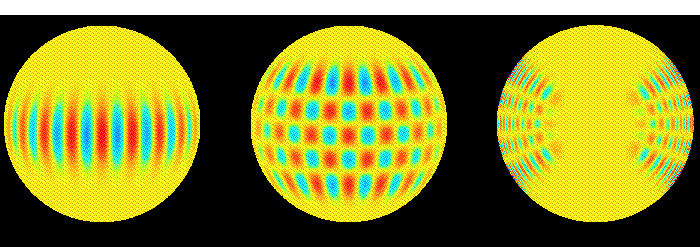
(Text and picture adapted from http://soi.stanford.edu/press/ssu8-97/pmodes.html)
The Sun is ringing, like a bell struck by many tiny sand
grains. The above pictures show three different ways (or "modes") to ring.
The Sun acts as a resonating
cavity, exhibiting millions of oscillation modes or standing waves.
Most people are familiar with oscillating modes in one
dimension: if you shake one end of a tight rope you can set
up an oscillating wave pattern that vibrates the whole rope back and forth
together. If you shake faster, stable patterns with two, three, or more
oscillations along the rope can be established. In these overtone patterns
are places in the rope that don't move, those are called nodes.
The patterns can be described mathematically with sine
waves of only certain wavelengths depending on the length of
the rope.
In two dimensions,
more modes of vibration are possible. Try putting a coffee mug on the counter
when the garbage disposal is running, and you may be able to see a fairly
complex two dimensional pattern on the surface with nodes lying along certain
fixed curves..
In three dimensions modes
can be described in terms of mathematical functions called spherical harmonics.
Spherical harmonics have characteristic spatial patterns with nodes located
both on the Sun's surface and radially within
the Sun.
Each mode is sensitive to the physical conditions where
the amplitudes of the mode are greatest. It is easy to see that the various
modes overlap, but that each one is sensitive to different
parts of the solar interior.
By combining
a large number of modes one can build up a picture
of what is happening throughout the solar interior, and in particular how
varies the rotation rates of the Sun with latitude and depth.
...Too see the tiny sand grains which cause the Sun to
resonate, click here...
